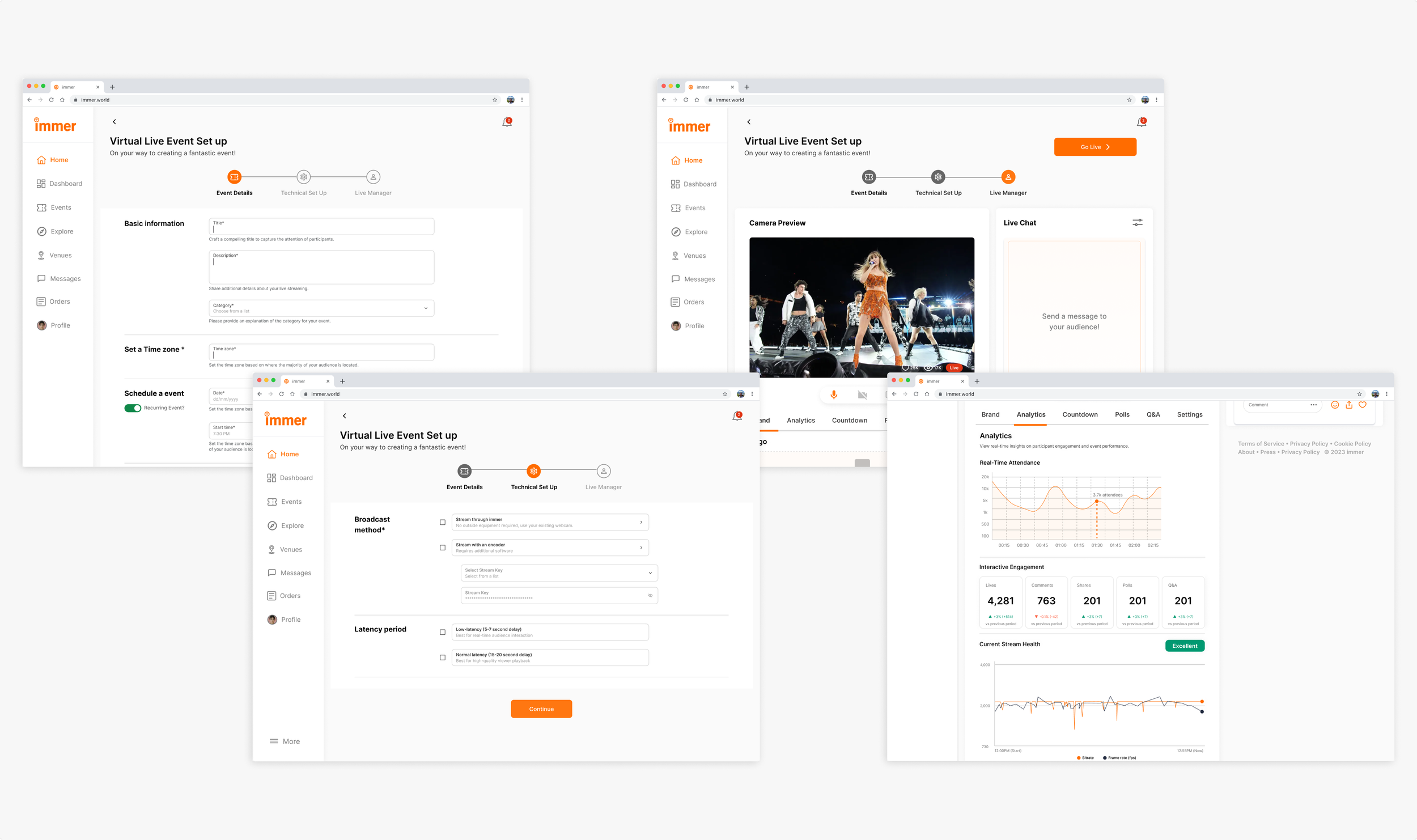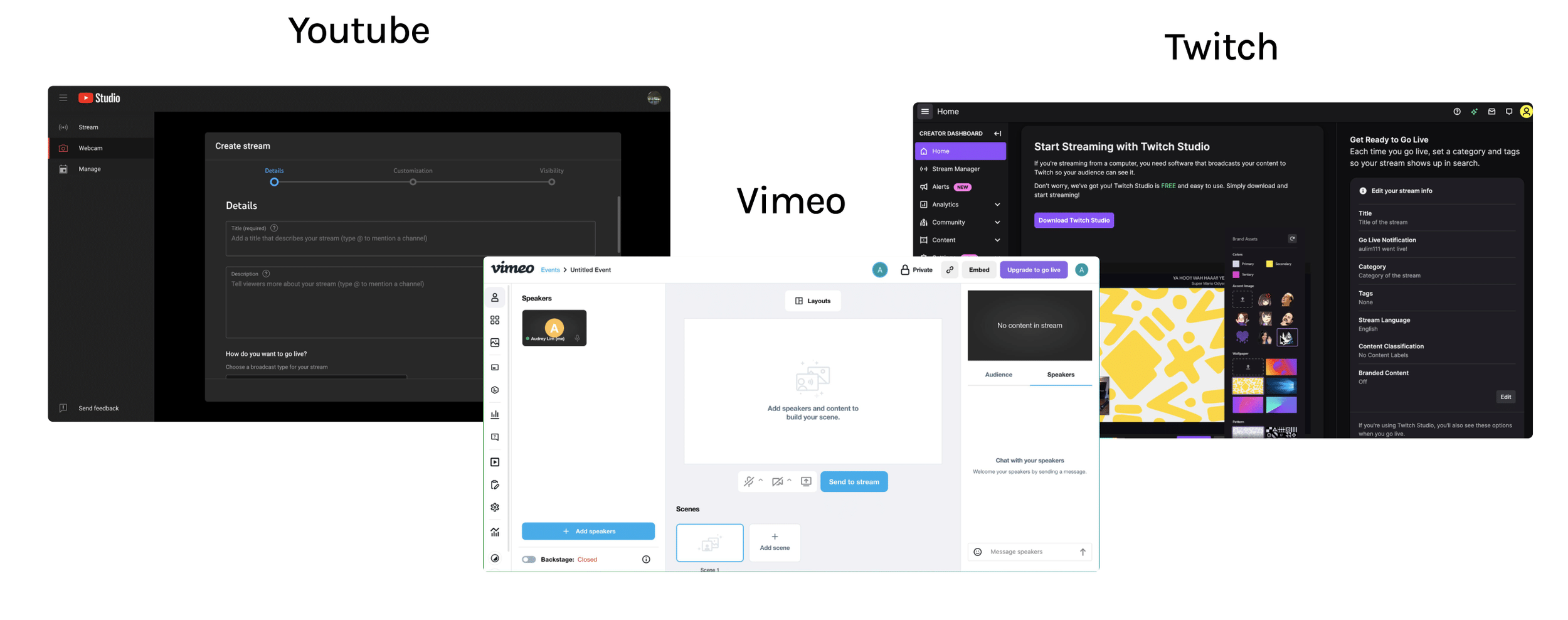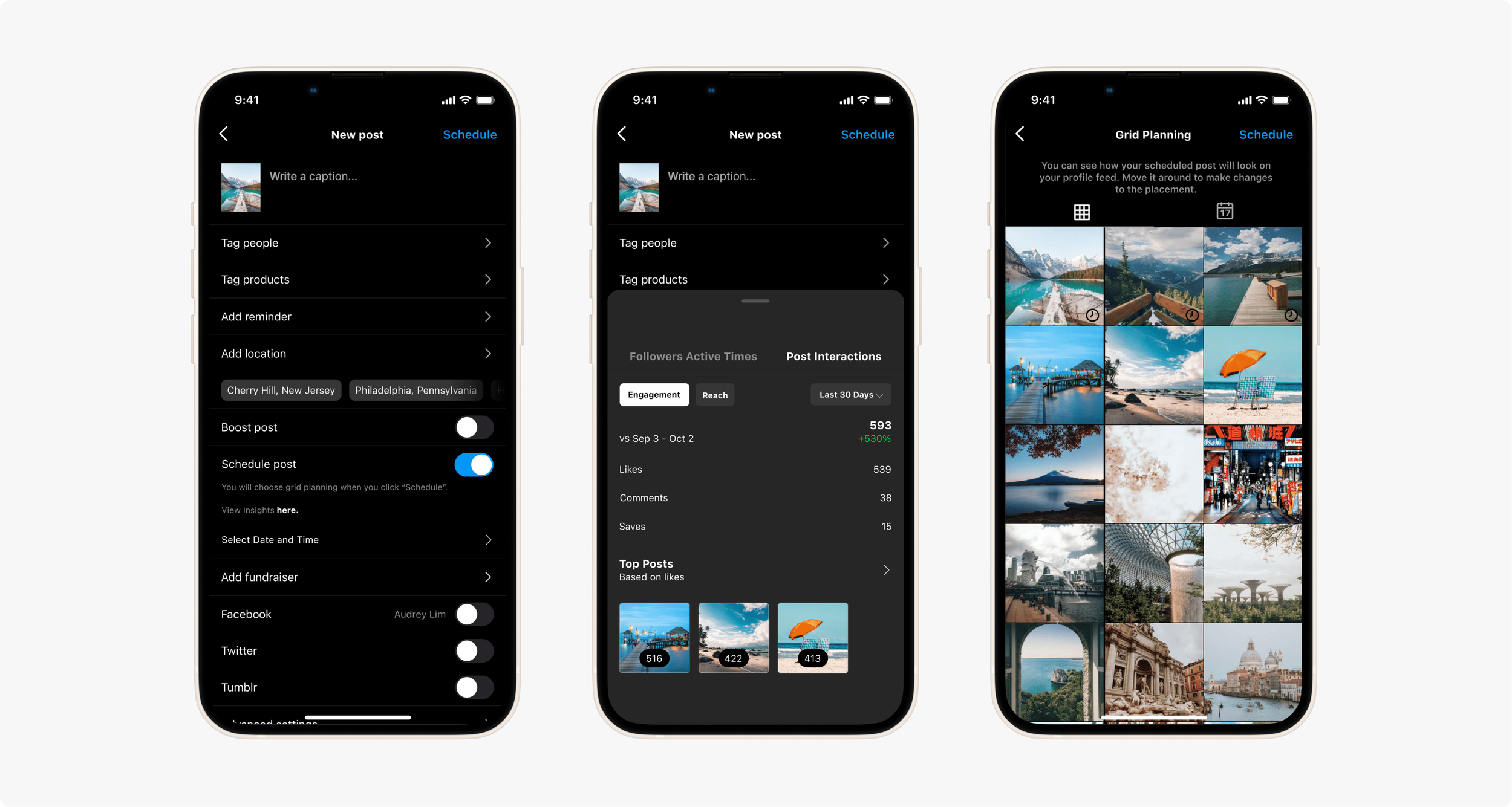Immer Feature Design
Revolutionizing the way entertainers interact with their audience virtually.
Immer, a pre-seed startup set to launch in 2024, aims to create an equitable ecosystem within the live event industry through an innovative platform that provides organizers and entertainers with tools to create, manage, and monetize events without the use of a promoter.
During my internship, I was a UX Designer who helped build out the organizer’s perspective of the Immer platform.
SUMMARY
ROLE
UX/UI, Research
TIMELINE
2 Weeks
TOOLS
Figma, Figjam
TEAM
3 UX Designers
CONTEXT
Working on the organizer’s viewpoint of a platform was super interesting I was super excited to learn and design a perspective of a platform that’s completely new to me. My team and I worked closely over four weeks to define and design our project. Our project brief required us to conceptualize and design a virtual live event setup that facilitated interactions between attendees and organizers/entertainers virtually.
Timeline
My team and I were given two weeks to develop the feature for Immer’s platform. We had a total of two stakeholder meetings for business-related direction and spent a total time of 2 weeks on iterations before developer handoff.
PROJECT BRIEF
Immer's platform focuses on empowering organizers to expand audience outreach and foster virtual connections through rich and dynamic event experiences. My team was tasked with designing an interface enabling seamless transitions from in-person to virtual events, allowing organizers to create and configure engaging live setups for interactive experiences.
The benefits of this feature is demonstrated by market research as follows:
93%
event marketers plan to invest in virtual events
51%
businesses reported higher return-on-investment from virtual events
73%
marketers see virtual events as vital in marketing due to high attendee engagement
THE CHALLENGE
A virtual live event set-up that balances usefulness and interactive customization.
We aimed for a user-friendly setup, ensuring ease of use while offering customization options for interaction within virtual live events. Consistency with other parts of the organizer platform was also a key consideration for this feature.
RESEARCH
Competitive Analysis
Due to budget and time constraints, we couldn't conduct user interviews. Instead, we relied on competitive analysis to inform our design decisions.
I researched competitors' setup flows and designs to gather inspiration and gain insights into what would be necessary to achieve our objectives effectively.
✍🏻 Key Takeaways
All platforms researched had varying interactive features and event set-up.
Integration of live analytics
Lack of branding customization or merchandise for advertising to attendees.
IDEATION
Behind the Scenes
My team organized our findings and collaborated to break down the feature into three main steps based off our competitive analysis and project brief:
Step 1: Event Details — all the basic information regarding the event
Step 2: Technical Set Up — Set up regarding broadcasting (camera/video source, video latency)
Step 3: Live Event Manager — Management and customization of the virtual event
We chose this information architecture to create a comprehensive yet user-friendly setup. Our goal was to provide all necessary information while enabling effortless and efficient navigation for users. We also decided to start with the heavy-duty setup information so users could focus on enjoying the live event and all its interactive features later in the task flow. By ending the setup process on a positive note, we wanted to leave users feeling confident and excited to engage with their audience.
DESIGN
Navigating through the unknown
Following our ideation, we decided to split up the work among the team and I mainly focused on the technical set up and the live event manager.
✧ Technical Set Up (My biggest challenge)
During our market research, we found encoders, specifically the OBS system, a common software supporting heavy-duty technicalities of broadcasting. This finding posed a roadblock, prompting a meeting with stakeholders to assess if Immer could accommodate a setup tailored to support heavy-duty technical broadcasting equipment within the allotted time frame. Lacking access and time, I went back to the drawing board to figure out how to integrate a third-party app into our technical setup instead of designing an OBS system-like setup from scratch.
With limited knowledge, I observed competitors using Stream Keys as secure identifiers to connect platforms and broadcast content to user accounts. This integration enables authorized software to broadcast, ensuring security in live streaming on Immer.
✧ Live Event Manager
From the user's perspective, I crafted the live event manager dashboard, focusing on streaming through Immer rather than an encoder because many of the features would remain the same. I aimed to maximize Immer’s platform features, as encoders typically encompass their own set of interactive features. This approach ensures Immer retains its feature-rich perspective if users decide to stream through their platform.
✧ Branding
I included various media options for users to customize their stream and include branding. Uploaded content in this section of the dashboard can be easily displayed on the screen with a simple click. Additionally, users can advertise merchandise to attendees during the live broadcast to drive sales.
✧ Analytics
Real-time analytics are crucial for organizers to understand their broadcast's impact and track event performance. Leveraging Immer's design system, I designed various analytics to help users monitor their event and make real-time adjustments as necessary.
RESULTS
Constraints
With Immer being a startup, we lack the resources and time to run a proper long-term usability test for the feature we designed. However, after meeting with other designers from Immer’s different teams and the CEO, we gained positive feedback, stating that they enjoyed the overall design and flow of the feature. We were also later told that our design was being used for the framework of another feature to be introduced later in the platform.
After many rounds of iterations and team meetings, we came up with a feature that encompasses both usefulness and easiness in setting up and an all-in-one platform for users to easily customize and monitor their virtual live event in one space. Our MVP project successfully passed review and was handed off to the development team (yay!).
We’re not done…yet
With Immer aiming to launch their MVP product by mid-late 2024, our teams were running on a time crunch. Despite functional designs, I feel they could be more refined, especially regarding features on the live manager dashboard. Given more time, I would have liked to conduct a more thorough user research process and performed usability testing to enhance the product further.
CONCLUSION
What I Learned
This was my first team project ever and it was so eye-opening how much you can learn from others and getting fresh pair of eyes on my designs made a world of a difference. I learned so much just from seeing the approaches my other teammates took in designs! This experience was highly rewarding and really set the tone in my work style and design ethic.
Be on the lookout for Immer’s launch to see my work live in 2024!
Read my other case studies!
Scheduling feature to support content creators improve their engagement and outreach.
Medipill
Combating medical non-adherence and improving health management.









